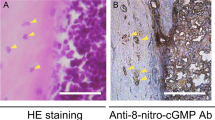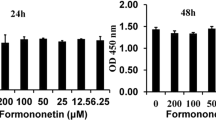Summary
Arachidonic acid, added to α-minimum essential medium containing 10% fetal bovine serum at the final concentration of 10−4 M, significantly increased DNA content of an osteoblastic cell line, MC3T3-E1, along with an increase of DNA synthesis. No growth-stimulatory effect of arachidonic acid was observed under serum-free condition. α-Linolenic acid, which cannot be converted to arachidonic acid, also increased DNA content at 10−4 M. Additionally, the stimulatory effects of these fatty acids were not inhibited by simultaneous addition of 10−5 M of indomethacin. Indomethacin, when added to α-minimum essential medium with 10% fetal bovine serum, also significantly increased DNA content of MC3T3-E1 cells. These results suggest that arachidonic acid may potentiate the growth-stimulatory effect of serumderived growth factors probably via noneicosanoid mechanism. Rat osteogenic sarcoma cell line, UMR106, also showed an increase in DNA content with arachidonic acid treatment. Hence, it is suggested that arachidonic acid may stimulate proliferation of cells of osteoblastic lineage. It is also suggested that indomethacin, probably by blocking endogenous prostaglandin E2 synthesis, stimulates cell growth in MC3T3-E1 cells.
Similar content being viewed by others
References
Spector AA, Mathur SN, Kaduce TL, Hyman, BT (1981) Lipid nutrition and metabolism of cultured mammalian cells. Prog Lipid Res 19:155–186
Bailey JM, Dumber LM (1973) Essential fatty acid requirements of cells in tissue culture: a review. Exp Mol Pathol 18:142–161
Gerschenson LE, Mead JF, Harary I, Haggerty DF Jr (1967) Studies on the effects of essential fatty acids on growth rate, fatty acid composition, oxidative phosphorylation and respiratory control of HeLa cells in culture. Biochem Byophys Acta 131:42–49
Dubin IN, Czernobilsky, B, Herbst B (1965) Effect of albumin fraction and linoleic acid on growth of macrophages in tissue culture. J Natl Cancer Inst 34:43–51
Holley RW, Baldwin JH, Kiernan JA (1974) Control of growth of a tumor cell by linoleic acid. Proc Natl Acad Sci USA 71:3976–3978
Kidwell WR, Monaco ME, Wicha MS, Smith GS (1978) Unsaturated fatty acid requirements for growth and survival of a rat mammary tumor cell line. Cancer Res 38:4091–4100
Wennerstrom DE, Jenkin HM (1976) The effect of two isomeric octadecenoic acids on the lipid metabolism and growth of Novikoff hepatoma cells. Biochem Biophys Acta 431:469–480
Setty BNY, Dubowy RL, Stuart MJ (1987) Endothelial cell proliferation may be mediate dvia the production of endogenous lipoxygenase metabolites. Biochem Biophys Res Commun 144:345–351
Bandyopadhyay GK, Imagawa W, Wallace D, Nandy S (1987) Linoleate metabolites enhance the in vitro proliferative response of mouse mammary epithelial cells to epidermal growth facter. J Biol Chem 262:2750–2756
Wicha MS, Liotta LA, Kidwell WR (1979) Effect of free fatty acids on the growth of normal and neoplastic rat mammary epithelial cells. Cancer Res 39:426–435
Sudo H, Kodama H, Amagai Y, Yamamoto S, Kasai S (1983) In vitro differentiation and calcification in a new clonal osteogenic cell line derived from newborn mouse calvaria. J Cell BIol 96:191–198
Yokota K, Kusaka M, Ohshima T, Yamamoto S, Kurihara N, Yoshino T, Kumegawa M (1986) Stimulation of prostaglandin E2 synthesis in cloned osteoblastic cells of mouse (MC3T3-E1) by epidermal growth factor. J Biol Chem 261:15410–15415
Hakeda Y, Yoshida T, Nakatani Y, Kurihara N, Maeda N, Kumegawa M (1986) Prostaglandin E2 stimulates DNA synthesis by a cyclic AMP-independent pathway in osteoblastic clone MC3T3-E1 cells. J Cell Physiol 128:155–161
Labarca C, Paigen K (1980) A simple, rapid, and sensitive DNA assay procedure. Anal Biochem 102:344–352
Snedecor GW, Cochran WG (1980) Statistical methods. The Iowa State University Press, Ames, Iowa
Duncun DB (1955) Multiple range and multiple F tests. Biometrics 11:1–42
Naughton JN (1981) Supply of polyenoic fatty acids to the mammalian brain. Int J Biochem 13:21–32
Mead JF (1984) The non-eicosanoid function of the essential fatty acids. J Lipid Res 25:1517–1521
Wolf BA, Turk J, Sherman WR, mcDaniel MI. (1986) Intracellular CA2+ mobilization by arachidonic acid J Biol Chem 261:3501–3511
Zeitler P, Handwerger S (1985) Arachidonic acid stimulates phosphoinositide hydrolysis and human placental lactogen release in an enriched fraction of placental cells. Mol Pharmacol 28:549–554
Hokin LE (1985) Receptors and phosphoinositide-generated second messengers. Ann Rev Biochem 15:205–235
Gowen M, Wood DD, Russel RGG (1985) Stimulation of the proliferation of human bone cells in vitro by human monocyte products with interleukin-1 activity. J. Clin Invest 75:1223–1229
Bressot C, Meunier PJ, Chapuy MC Lejeune E, Edouard C, Darby AJ (1979) Histomorphometric profile, pathophysiology and reversibility of corticosteroid-induced osteoporosis. Metab Bone Dis and Rel Res 1:303–311
Wallner BP, Mattaliano RJ, Hession C, Cate RL, Tizard R, Sinclair LK, Foeller C, Chow EP, Browning JL, Ramachandran KL, Pepinsky RB (1986) Cloning and expression of human lipocortin, a phospholipase A2 inhibitor with potential anti-inflammatory activity. Nature 320:77–81
Author information
Authors and Affiliations
Rights and permissions
About this article
Cite this article
Fujimori, A., Tsutsumi, M., Yamada, H. et al. Arachidonic acid stimulates cell growth in an osteoblastic cell line, MC3T3-E1, by noneicosanoid mechanism. Calcif Tissue Int 44, 186–191 (1989). https://doi.org/10.1007/BF02556563
Received:
Revised:
Issue Date:
DOI: https://doi.org/10.1007/BF02556563




